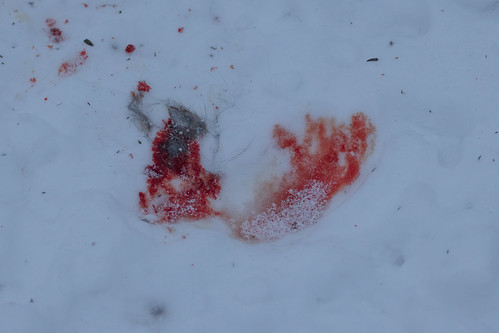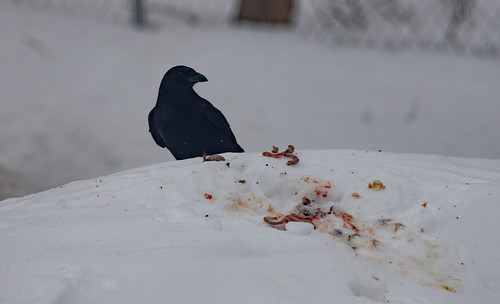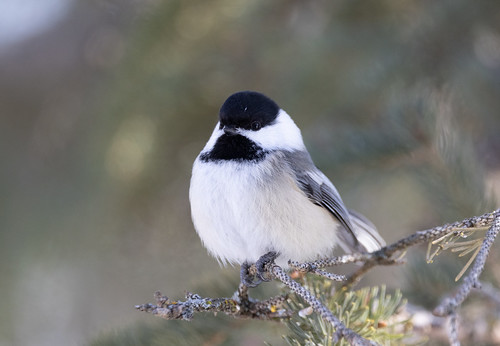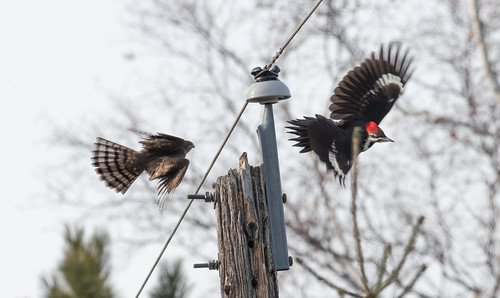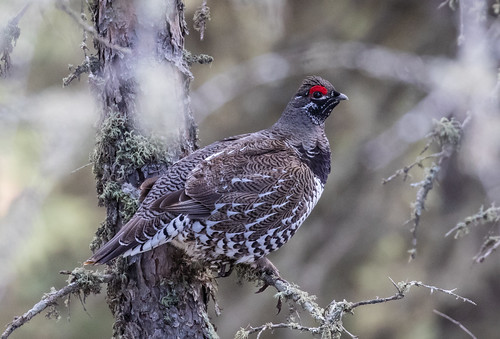Every year I celebrate March 2 as Chickadee Day, because it’s the anniversary of the day I saw and identified my first Black-capped Chickadee, Number One on my life list. This year I was hungry to see a Spruce Grouse, so I got up while it was still dark to drive up to Two Harbors and then up Highway 2 and Highway 1 toward Ely. Before I even had my coffee, I had to let my dog Pip outside. She's little, weighing just 8 pounds, and there are plenty of predators in the neighborhood, so I take her out on the leash after dark. This time, she instantly ran to a dark spot in the snow and started sniffing a deep red bloody spot and one little tuft of cottontail fur on the ground by the feeder, at the corner of an area of the backyard that Russ keeps shoveled for Pip to get around easily. By the light of our porchlight, I could also see a few pieces of the rabbit on the snowbank just above. I went in and got a flashlight to confirm what I was seeing.
I’m pretty certain the perpetrator was one of the neighborhood Great Horned Owls because there were no tracks going up the snowbank, so the predator had to have flown there. A Great Horned Owl is the most likely nocturnal predator that could fly any distance at all with an adult rabbit carcass.
Great Horned Owls often bite off and swallow a rabbit's head, and if scared off or not very hungry, they leave the rest. In this case, the head was missing, but so was almost all the rest of the body, so I’m presuming this was one hungry owl or, even more likely, a mated male who ate the head and lugged off much of the rest to give its mate on the nest. By now the female may be brooding, in which case dad was bringing food for both her and their chicks. I love owls and I’m glad someone got a good meal even as I devoutly wish it hadn’t been one of my bunnies.
Anyway, I got dressed and waited for it to get light enough outside to take photos of the gruesome crime scene. But even before sunrise, two of my crows showed up. I didn’t begrudge them the calories, but I ran out to take pictures before they could carry away what was left, while it was still too dark for good photography. My crows are skittish whenever anything is out of the ordinary, like this sudden bonanza of rabbit guts on the snow, so I photographed them from indoors through the window glass. My photos ended up pretty poor, but oh, well.
Chickadees were singing away. That happens to be one of the loveliest bits of serendipity about my starting birding on March 2—when I haven’t been traveling, I don’t think I’ve ever missed hearing chickadees singing on March 2.
While I was packing up my camera gear, I spotted a male Pileated Woodpecker at the suet feeder, and after watching him through binoculars for at least a minute, he finally posed exactly right for me to see the band on his right leg—yep, it was my dear BB.
BB, at least one unbanded male, and at least one female Pileated had been coming multiple times every day through quite a bit of the winter. In the last couple of weeks I haven't seen any of them around most days, but this was the third day in a row that BB showed up, which was a joy. A minute or two later, when I was putting on my coat, BB flew away in a weird, zig-zagging flight, pursued by someone I couldn’t get a clear look at. They completely moved out of sight, and I don’t know how that encounter ended up. In the past I’ve photographed a very determined Sharp-shinned Hawk repeatedly chasing a female Pileated and seen Merlins harassing raptors larger than Pileateds. We’ve had both sharpies and Merlins this year, so either is a possibility, along with such real menaces to Pileateds as Northern Goshawks, so I’ll be uneasy until I see BB again.
On balance, Chickadee Day was starting out pretty rough, but a lovely drive to see Spruce Grouse would certainly brighten things up, right?
People have been seeing them on Highway 1 just north of the Spruce Road, so that’s where I headed. Going through the eerie, burnt area by the Sand River made me sad—the Greenwood Fire last year destroyed so much habitat!—but the grouse have been seen here a few times this winter so I kept careful watch. The only two times a car came up behind me, I had plenty of room on the shoulder to pull over before they were inconvenienced, so I drove nice and slow, scrutinizing the road ahead and the trees along the road, but no luck. Two small flocks of redpolls flew up from the road ahead of me, but I’d seen them way better already that very morning in my own backyard, and the only other birds I saw up there, ravens, had also made an appearance on Peabody Street.
Driving home as I revisited Highway 61, I saw a few Bald Eagles—the only species I saw on that entire long drive that I hadn’t already seen at home. I didn’t have time to stop in Two Harbors or any of my favorite spots—I was already late getting to my daughter’s house for babysitting. My Chickadee Day adventure was a total bust.
A small flock of Cedar Waxwings was in Katie’s backyard, but now that I had something to photograph, I’d left my camera at home. The one big bright spot over there was Walter. He's not quite at the talking stage yet, though he often points to the feeder and says "chee!" when he spots a chickadee. On Chickadee Day when I asked him what a chickadee says, he said, "dee dee dee." A boy after his grandma's heart.
The moment I got home a little after 4, while I was still taking my coat off, I got a text message from a dear friend of mine, Sarah Glesner, who was right that moment looking at a Chukar at her parents’ place a half mile away.
Chukars are Old World grouse—the national bird of both Iraq and Pakistan. They are beautiful birds belonging to the same family as pheasants and grouse, and so have been introduced as game birds in many countries. In the United States, state departments of natural resources have introduced them many times over the years, including in Minnesota and Wisconsin, but Chukars have become established only locally here and there in the West. They’re easy to raise in captivity, so are often found in private aviaries. They’re also a popular quarry for canned hunts at game farms catering to unsportsmanlike shooters, and are also kept by retriever clubs for training and competitions.
Last summer, a group of Chukars were hanging out in Sarah’s parents’ part of the neighborhood after apparently staging a great escape. I got photos of one of them on July 13.
By then, the original flock had dwindled, and one by one, the remaining numbers shrunk. That area is closer to where the Great Horned Owls usually hang out than my yard is, and our neighborhood has plenty of foxes as well as being located right under Hawk Ridge. I hadn’t heard anything more about the Chukars by August, so I assumed the whole flock had died out, but Sarah said this one individual has been showing up at her parents’ feeder most afternoons all winter.
I was at their door a few minutes after getting her message. I thought I’d have to do a bit of work to find a good spot with an angle where I could take good pictures without scaring off the bird, but nope. It was walking up her front sidewalk to her porch as I arrived, while she was standing on the porch. It sauntered up the steps like it lived there, and stayed right there on the porch where Sarah and I both stood for ten full minutes before it jumped down and wandered to the back yard, apparently not minding us talking to each other as I clicked away. I took about 350 photos of which 270 turned out, as Sarah took a few of me.
This bird can fly—Sarah has seen it up on rooftops—but there’s no pretending any of my photos were taken in a wild setting. That's okay—even if I prefer taking pictures of birds in my trees rather than in my feeders, I am not into misleading people about birds or pretending I'm some rugged wildlife photographer when I'm really just a birdwatcher who takes a lot of pictures. And there's no pretending this little beauty belongs anywhere near Duluth. It may not be countable on any birding lists, but it’s as wild as an escapee from domestication can be, and it made a lovely and serendipitous end to what had been an otherwise mostly dispiriting Chickadee Day.

